At the beginning of March, Union Saint-Gilloise were flying in the Belgian Pro League, with it looking like Alexander Blessin’s side would go into the Championship playoff round with a little bit of breathing space over second-placed Anderlecht after the points were halved. However, their form started to fall off after that victory against Leuven on March 2nd, with Blessin’s side dropping points in their final two regular-season games against Gent and Antwerp while also losing over two legs in the Conference League Round of 16 to Fenerbahçe.
This meant that USG went into the Championship playoff round with only a 3-point lead over Brussels rivals Anderlecht, and now that gap is completely gone after the first round of fixtures, after Anderlecht beat Antwerp, and USG lost away to Genk. This tactical analysis and scout report will take a more detailed look at the recent defeat to Genk while also digging a little bit deeper into the recent defensive struggles of Union Saint-Gilloise as we look at some common trends from their recent loss to Fenerbahçe and draws to Gent and Antwerp.
USG’s current defensive struggles analysed
The main problem that has plagued USG in their recent fixtures is the tendency for their defensive shape to be broken rather easily, with this likely frustrating Blessin and his coaching staff, mainly due to Union Saint-Gilloise being one of the best sides in Belgium defensively over the course of the regular season. Another thing likely to frustrate the German coach is the fact that the defensive lapses have been poor and could have easily been prevented, as the following examples will highlight and discuss in more detail.
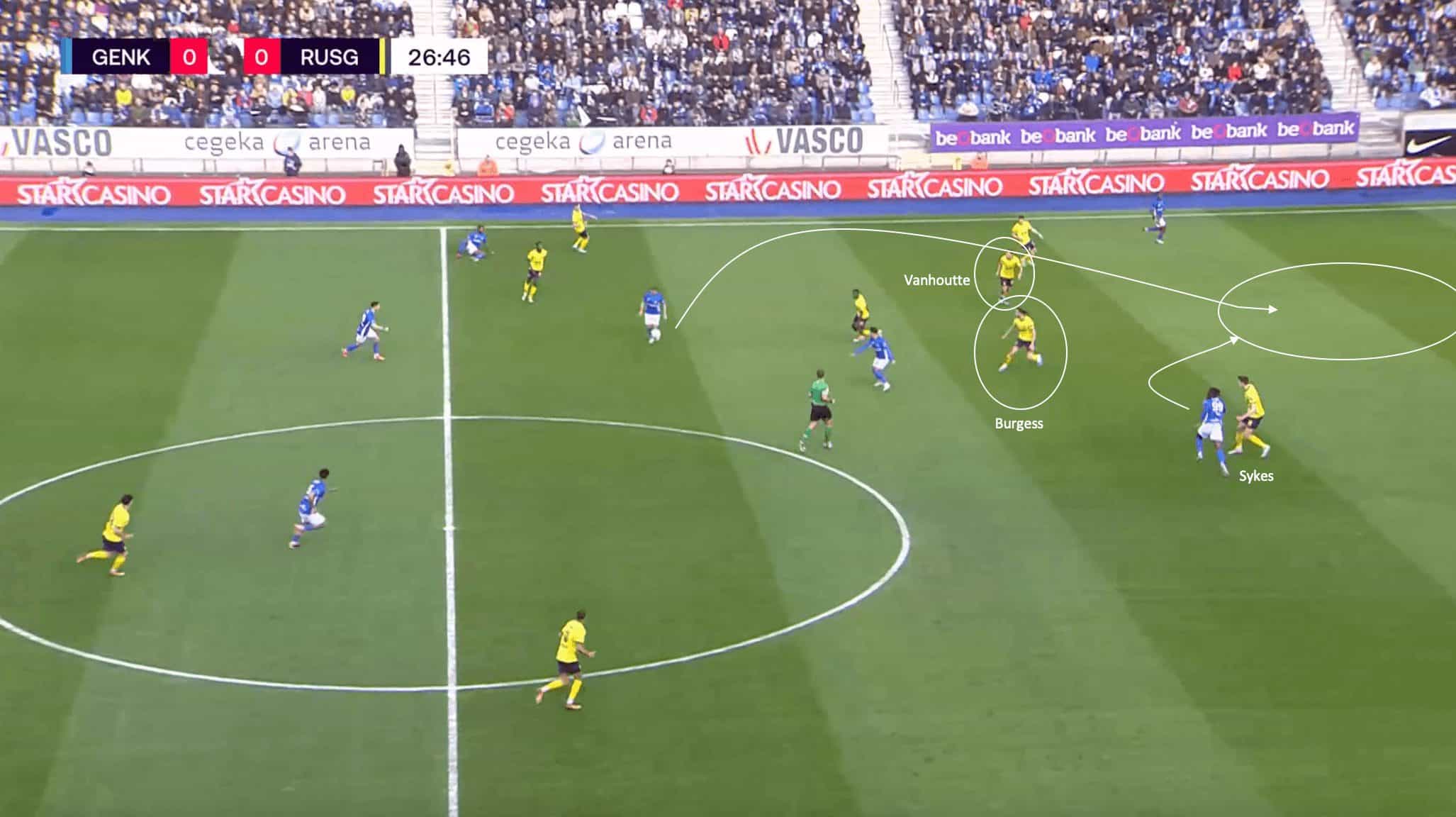
The image above shows the initial phase of Genk’s winning goal against the current league leaders on Monday evening. The phase starts from a goal kick for Genk, with RB Leipzig-bound Maarten Vandevoordt playing out from the back, with Wouter Vrancken opting to match Blessin with a back three formation and look to go man-to-man with Union Saint-Gilloise. The ball is progressed towards midfield down the far touchline, with wingback Joris Kayembe driving forward before playing a pass centrally to Patrik Hrošovsky, who is currently in possession in this image.
The USG backline are caught high, with central centre-back Christian Burgess being responsible for holding the line and playing the offside trap. The 32-year-old former Arsenal and West Ham United youth player looks to advance the line, noticing the positioning of Genk striker Tolu Arokodare on the shoulder of the last defender. However, while emergency centre-back Charles Vanhoutte does step up with Burgess, bother wingback Alessio Castro-Montes and left-sided central defender Ross Sykes fail to step, with Hrošovsky able to play a ball over the top and behind the USG backline.
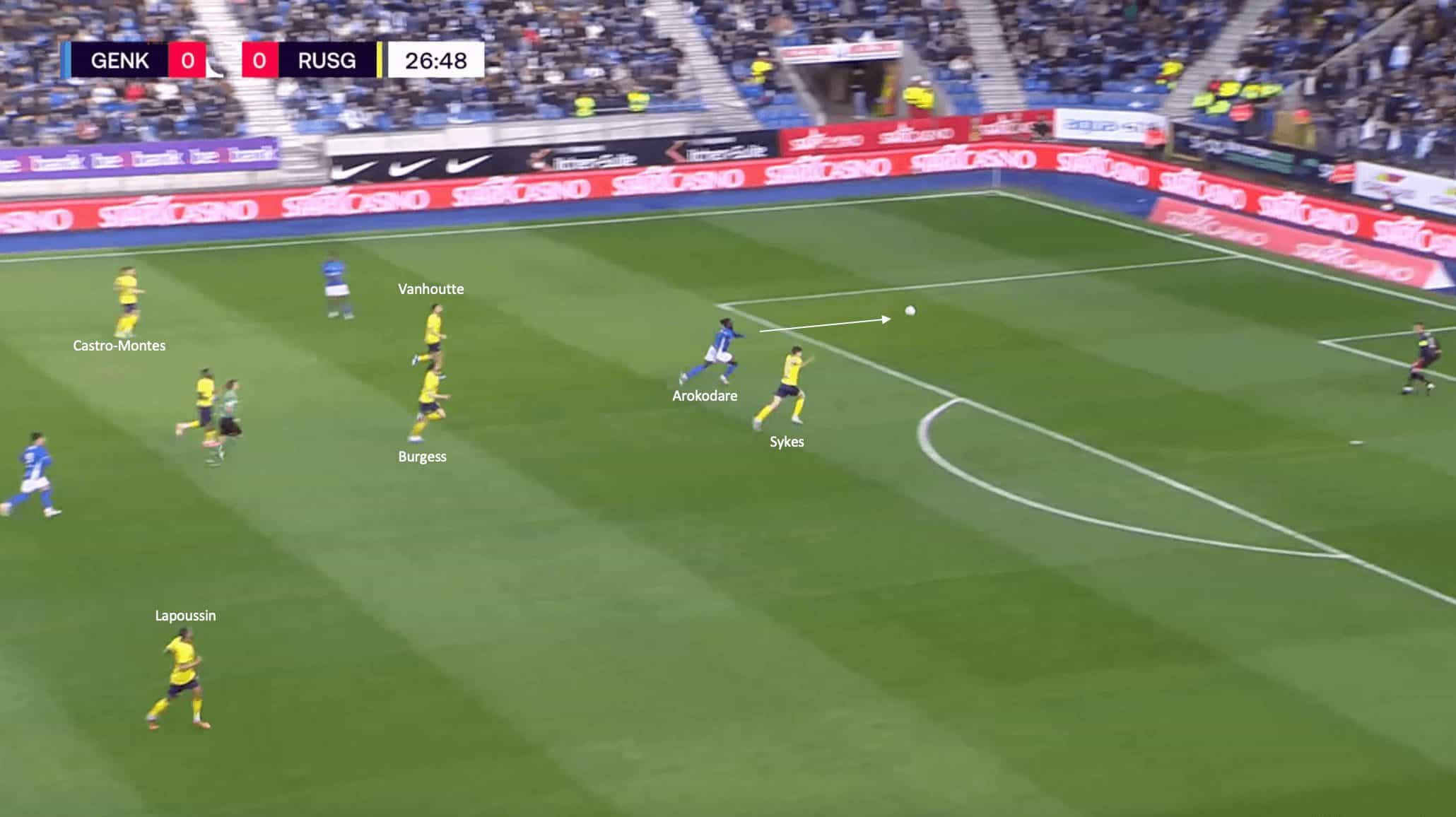
The image above shows what happens as the play progresses, and the ball is played over the top to Arokodare. Notice the positionings of the USG backline, with both wingbacks, Castro-Montes and Loïc Lapoussin, still very advanced, while the three centre-backs are very disconnected and detached, with only Sykes in any sort of position to challenge the Genk striker as he runs onto the end of the ball inside the penalty area.
As a result, Arokodare ends up taking a shot first time past Anthony Moris, with Sykes not able to get into a position to get a goal line clearance. Blessin is visibly frustrated with the defending of his side after the goal, with the camera showing him in his seat berating the defending of his side. This goal came from a lack of spatial awareness from the defensive unit, with USG’s normally rigid and compact defensive shape being broken rather easily by a ball over the top from midfield.
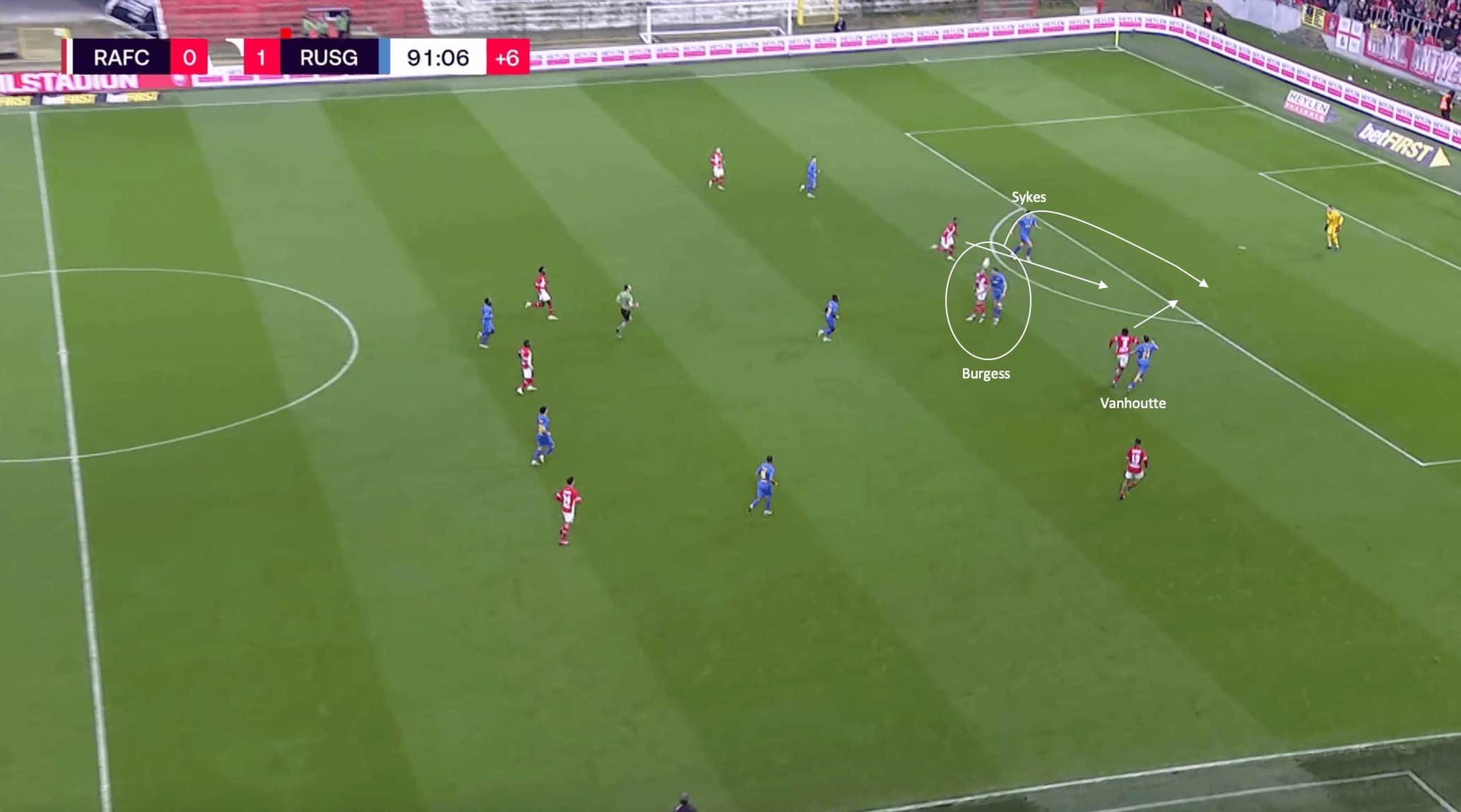
The image above shows another calamitous defensive error from Union Saint-Gilloise in their recent 1-1 draw with Antwerp at the end of the Belgian Pro League regular season. In added time at the end of the match, Antwerp goalkeeper Jean Butez played a ball long from his own half towards USG’s penalty area, with the initial 50/50 header being won by former Tottenham striker Vincent Janssen over Burgess.
With Burgess detaching from the defensive line to look to engage the Dutch striker in an aerial battle to attempt to clear the ball from danger, this opens up a gap behind the English centre-back for the two Antwerp attackers to run into to try and get onto the end of the flicked ball from Janssen. Ross Sykes gets caught ball-watching, while Vanhoutte gets caught on the wrong side of George Ilenikhena, with Moris freezing as well just outside of his six-yard box as the ball bounces inside the penalty area.
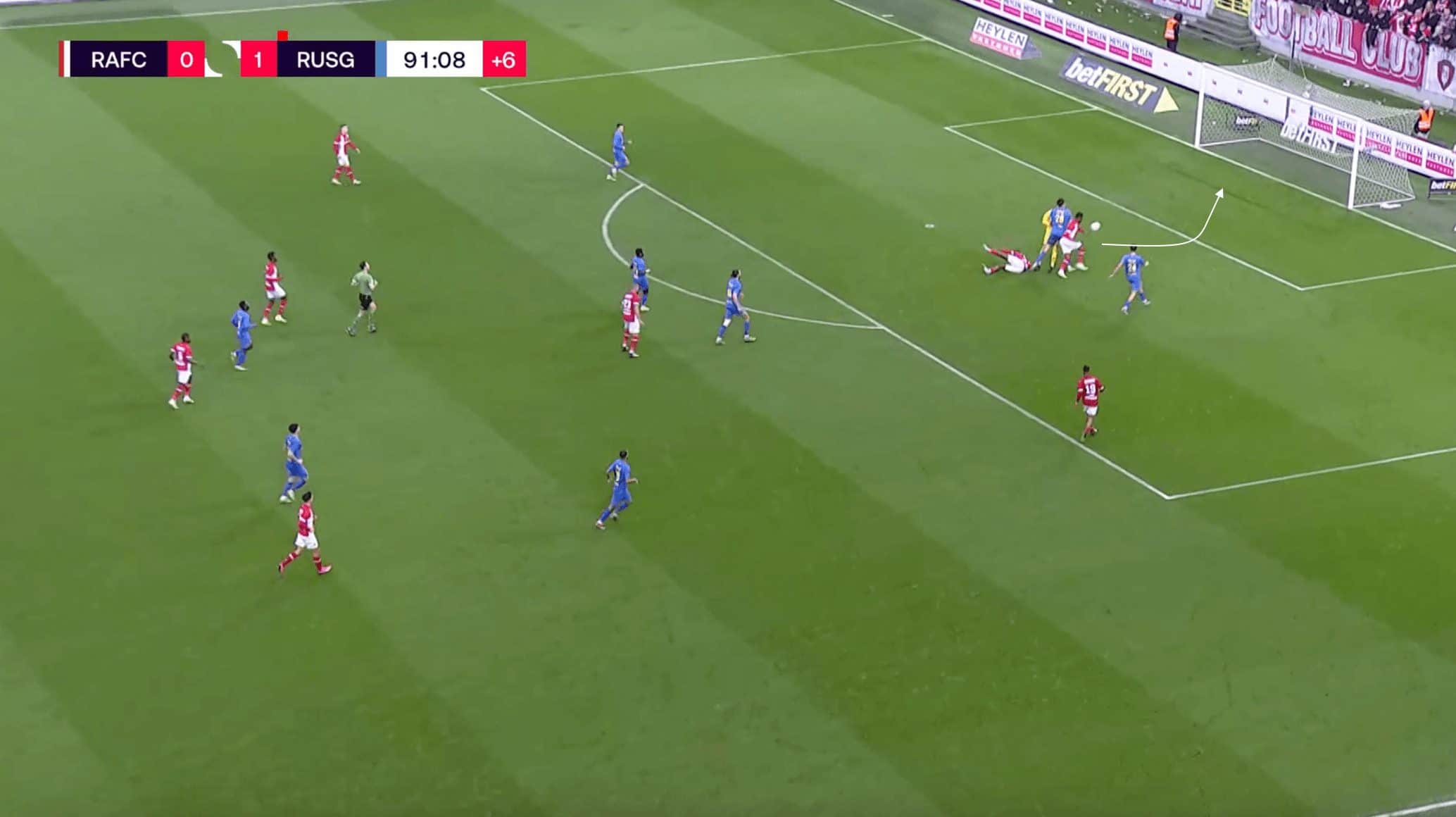
This figure above shows what happened after the ball bounces inside the 18-yard box, just to the right of the penalty spot. Sykes looks to shield the ball from the Antwerp attackers, Ilenikhena and Gyrano Kerk, anticipating that Moris will be able to come and grab the ball, potentially winning a foul in the process. However, the ball instead bounces right between the 25-year-old English centre-back and Luxembourg’s #1 goalkeeper, with the two colliding as a result and stopping their momentum, preventing them from reaching the loose ball quickest as it continues to roll towards the goal.
While Ilenikhena loses his balance and falls down, Kerk does not. The Dutch attacker is able to get onto the end of the loose ball before Sykes or Moris and easily finishes into the empty Union Saint-Gilloise net. Vanhoutte’s positioning is also poor in this defensive moment. The 25-year-old Belgian does not stay tight to his marker and is, as a result, in no position to impact the play in a positive way and prevent Kerk from scoring.
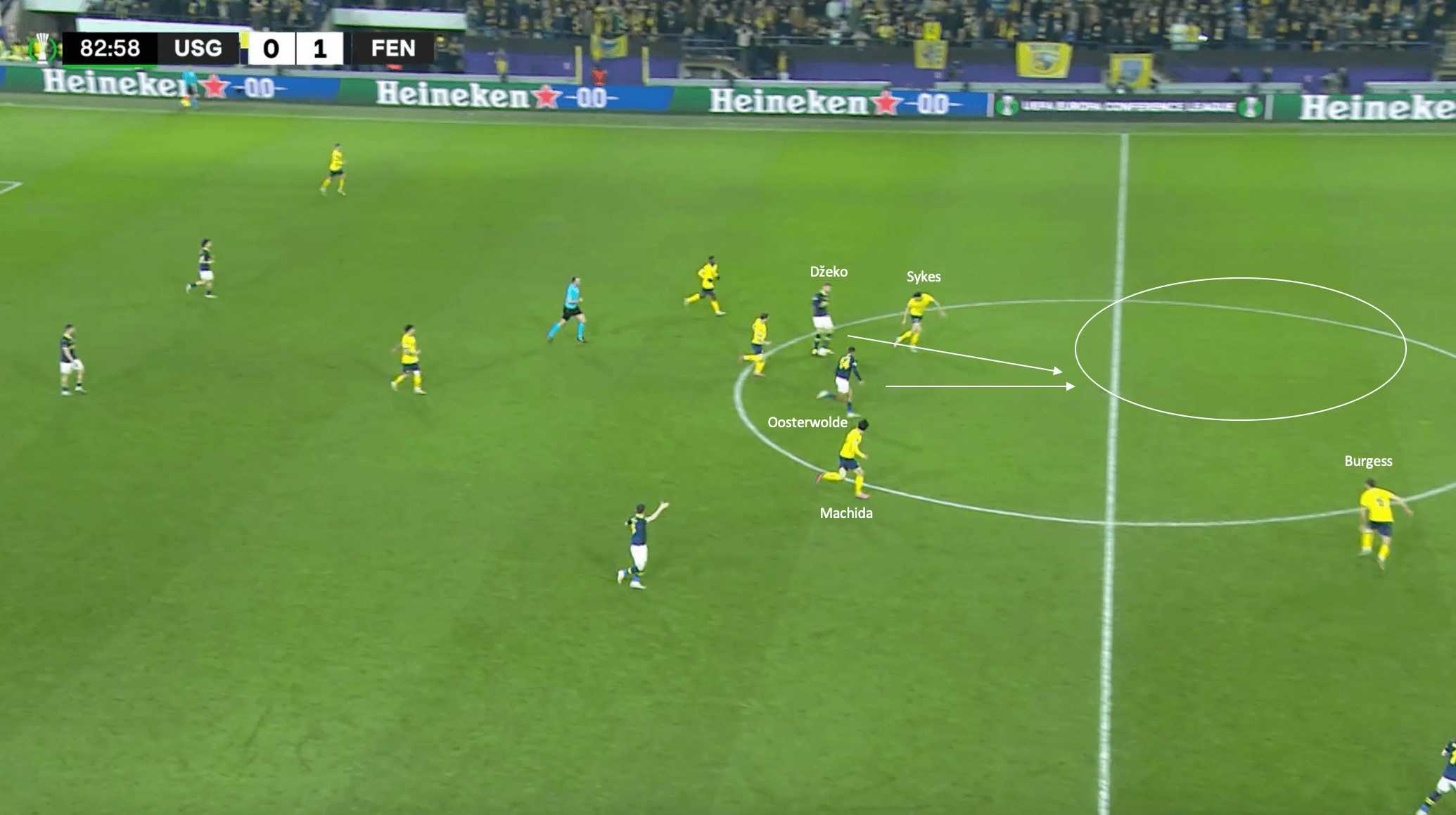
While backline shape during defensive phases of play has been an issue for Alexander Blessin’s side recently, transitional defending has also been a root cause of their recent defensive issues, with the first leg of their Conference League matchup against Fenerbahçe a prime example of these shortcomings. In this transitional defensive phase, USG have just turned possession over just outside the Fenerbahçe penalty box, with the Turkish side able to counterattack quickly.
Blessin’s side were slow to react and unable to get back into a feasible defensive shape, with the ball finding its way to Edin Džeko just inside the centre circle. The centre-backs are also poorly positioned and detached from each other, with Koki Machida and Sykes in the attacking half, and Christian Burgess by himself in the defensive half with an opposition attacker on the blind side of him.
This is an example of poor rest defending from Union Saint-Gilloise, with the Belgian side not set up well enough from a defensive standpoint before possession was turned over in order to put pressure on the ball as well as cover the space behind to prevent a quick counterattack. As a result, there is plenty of space behind the USG defensive line, with the 38-year-old Bosnian striker able to play a ball for Jayden Oosterwolde to run onto unmarked.
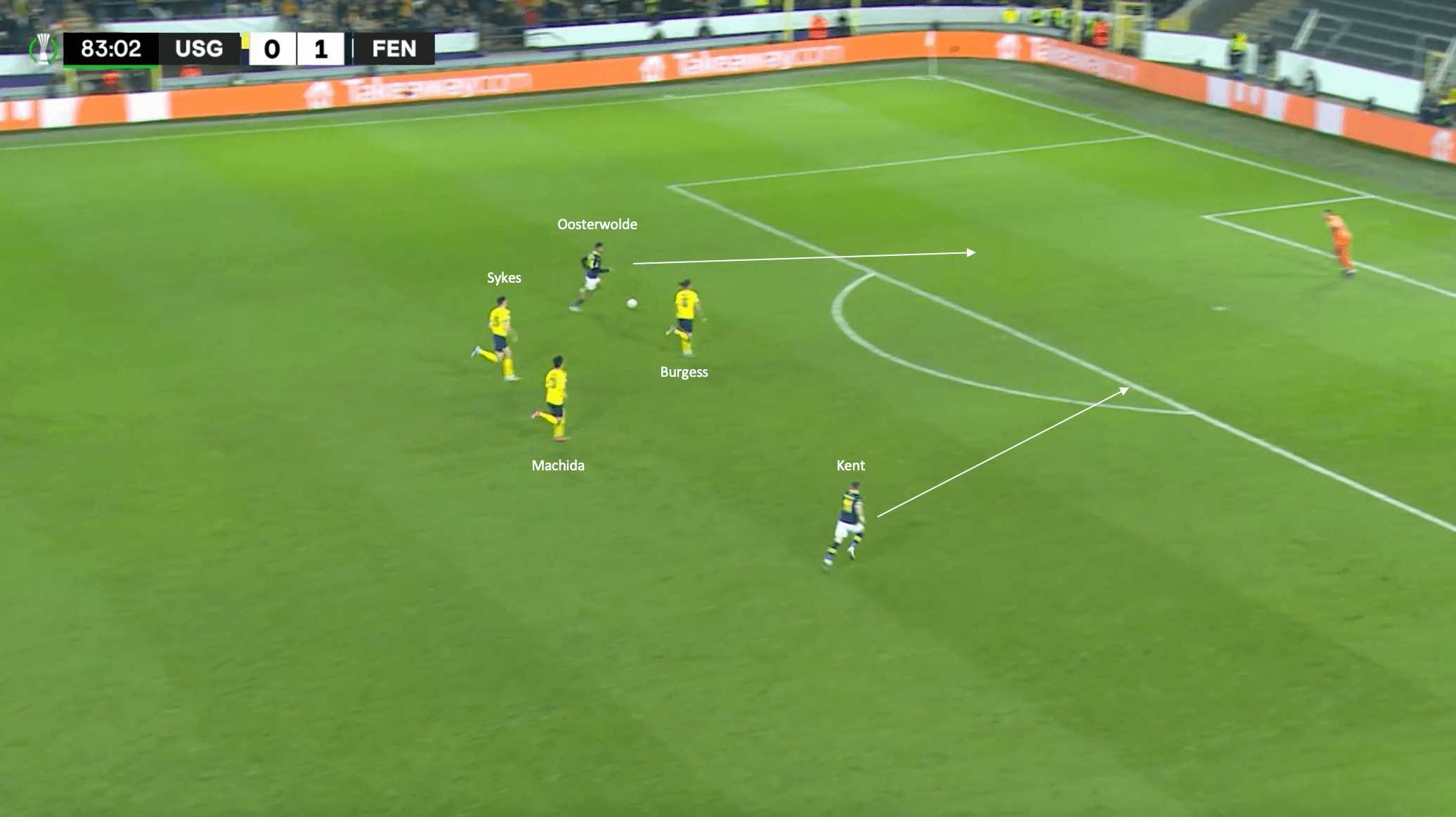
The image above shows the result of the poor rest defence from Union Saint-Gilloise at this counterattack. As the ball finds its way to Oosterwolde, the 22-year-old Dutchman is able to drive into the penalty area, with Ryan Kent also joining in on the attack, making it a 2v1 against Burgess, as Sykes and Machida struggled to recover quick enough to play any part in making a defensive action.
Oosterwolde is able to drive into the penalty box and shoot past Moris, giving Fenerbahçe a two-goal lead in the first leg and putting them almost completely out of reach. This goal was easily preventable for Blessin’s side, with USG not needing to commit many numbers forward considering the time left in the match, plus with the second leg that was still coming up the following week. That consideration aside, Union Saint-Gilloise’s best defence in this phase of play was poor, which led to the quick and clinical counterattack from the Turkish side.
As this section has been able to show and highlight, there have been plenty of defensive struggles for Union Saint-Gilloise in the recent weeks leading up to the Belgian Pro League Championship playoff round. A lot of these issues stem from either a lack of discipline defensively in the backline or lack of success in transitional defence. Now, let us take a quick look at how Alexander Blessin’s side were defensively in the earlier parts of the season, and where that differs from the struggles that are currently experiencing.
How do these struggles compare to earlier in the season?
While Union Saint-Gilloise have struggled defensively through their last five matches in all competitions, this has not been the case for the majority of the season with the Belgian side. In fact, Blessin’s side was one of the best sides defensively over the course of the regular season, with one of the lowest totals of goals conceded, level with second-placed Anderlecht.
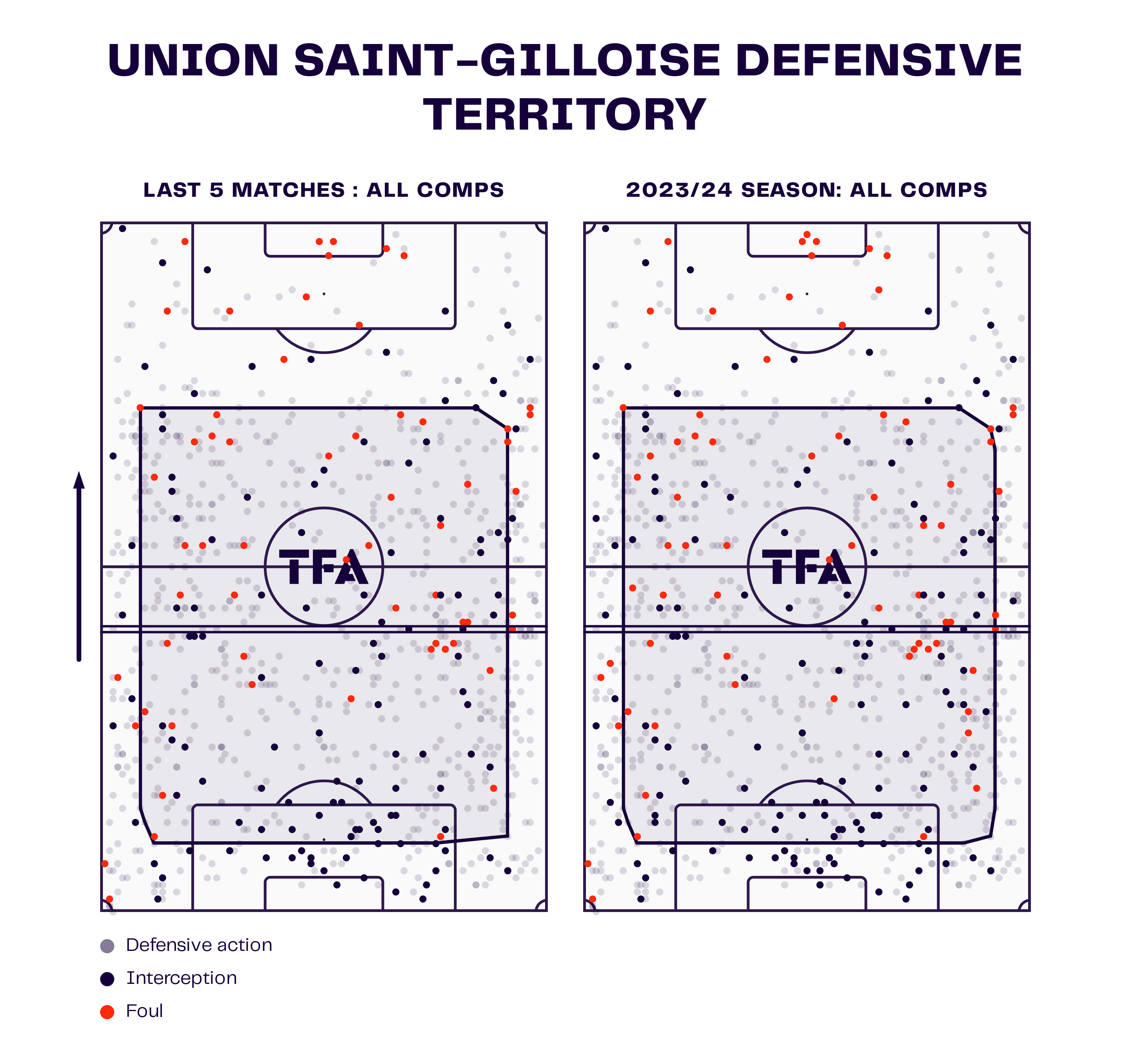
The data viz graphic above shows the defensive territory comparison of Union Saint-Gilloise, with the left figure showing their defensive territory over the last five matches, with the right figure showing their defensive territory over the course of the whole 2023/24 campaign in all competitions. As we can see, in the last five matches, USG have held a slightly higher defensive line. While it is a rather minuscule thing and doesn’t necessarily translate to the problems defensively that Alexander Blessin’s side has experienced in the last few matches, that means a lot of the defensive frailties looked at in the previous section point to being just uncharacteristically poor defensively in recent matches.
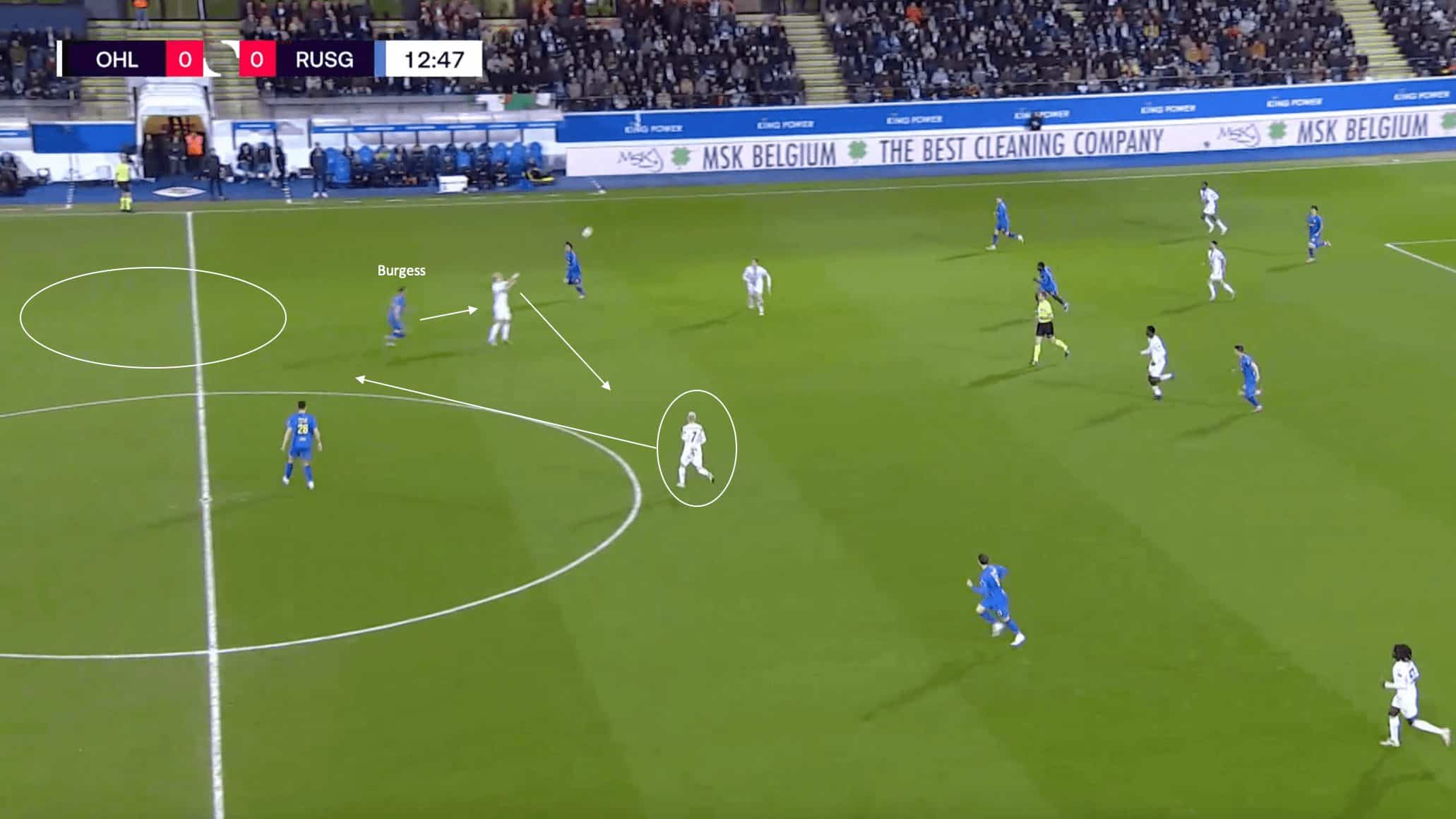
The image above shows a defensive phase of play from a match for USG earlier last month against Leuven. In this phase, the ball is played long from the Leuven goalkeeper to the striker, who has dropped into a pocket of space in the midfield. Notice how Burgess again tracks the striker into the midfield, leaving space behind him and in front of the rest of the defence.
As a result, the forward flicks the ball onto the midfielder in space to drive into. With Burgess caught out of position, the midfielder is able to continue to drive forward into the Union Saint-Gilloise half, but as the next figure shows, Blessin’s side was much more prepared for this route one direct attack due to their rest defence initially.
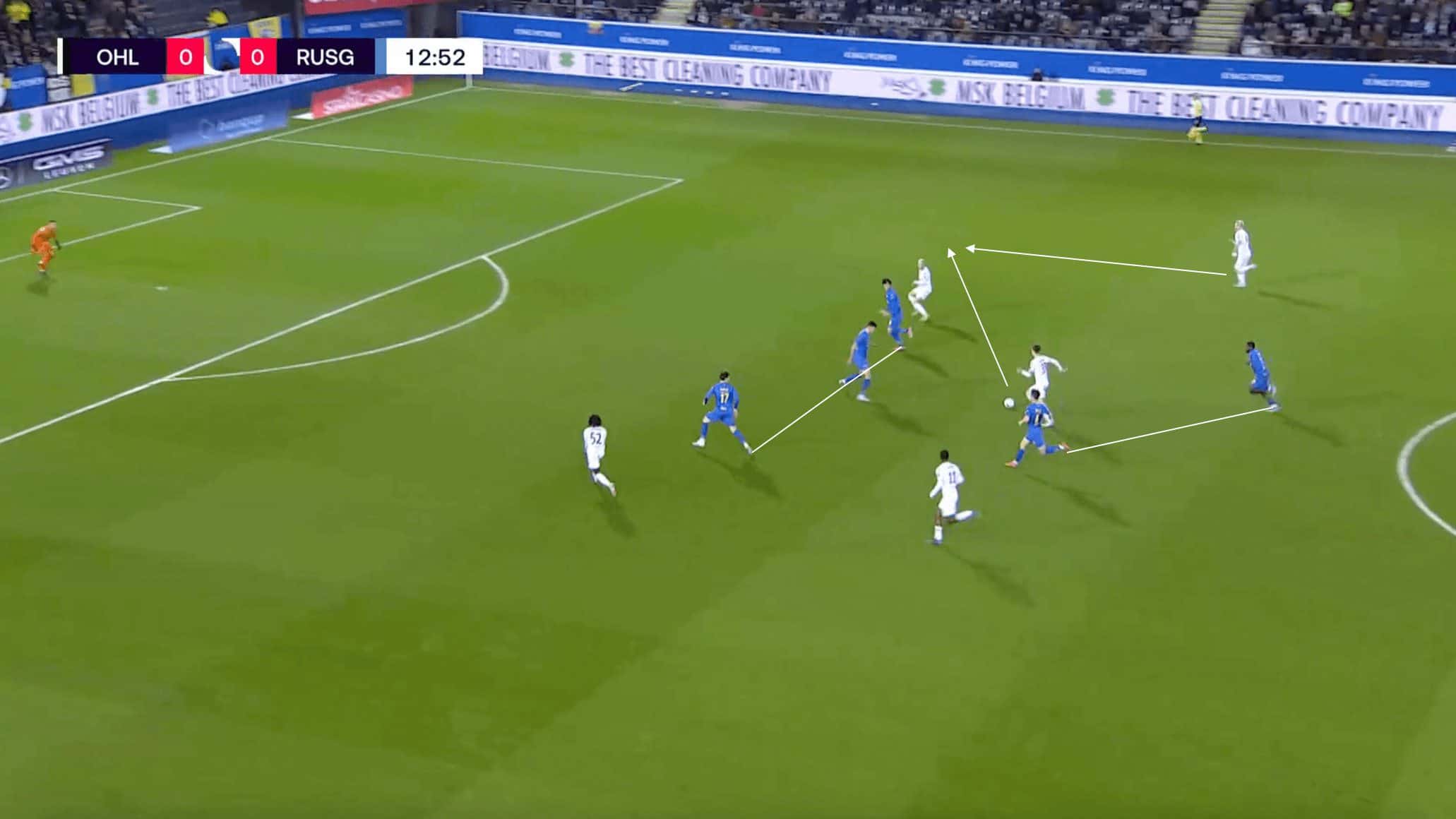
The image above shows how the defensive phase of play against Leuven continued to develop as they progressed towards the USG penalty area. As we can see, the rest of the Belgian side’s defensive line has been able to become compact and narrow, with two midfielders also able to track back to play a part in this defensive moment. This forces Leuven to play the ball into the wide channel, allowing USG to continue dropping back in a defensive shape while also forcing the play to the less dangerous area away from goal.
This better defensive shape comes from the better rest defence that Blessin’s side were able to demonstrate in this defensive phase of play. While the first part of this example was similar to the high line they have defended with in their more recent matches, they have been more prepared with their numbers behind the ball, working well to prevent good goalscoring chances.
Conclusion
As this tactical analysis has shown, nothing has changed in Alexander Blessin’s defensive tactics in the last few matches for Union Saint-Gilloise. Most of the issues have stemmed from poor defensive shape and marking, a lack of good rest defence at times, and occasionally problems with spatial awareness from players. Blessin hopes that these issues will be fixed in due course, especially as Union Saint-Gilloise continues to push for the Belgian Pro League title.





Comments